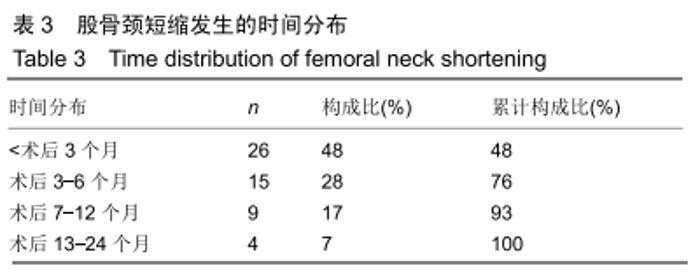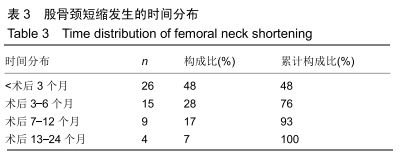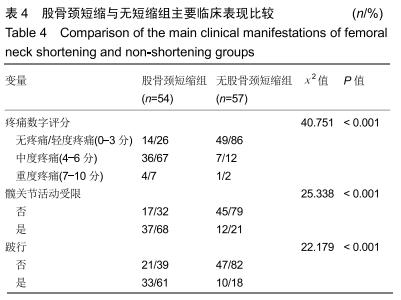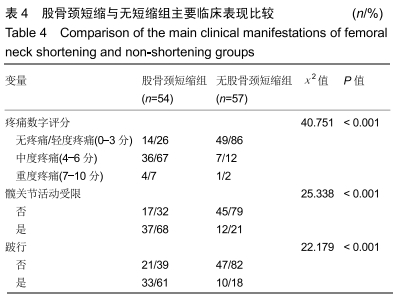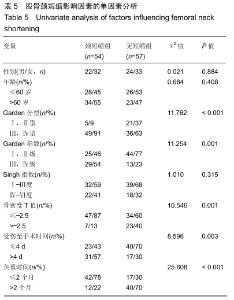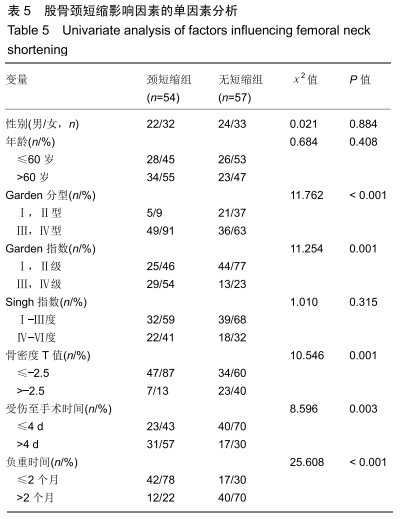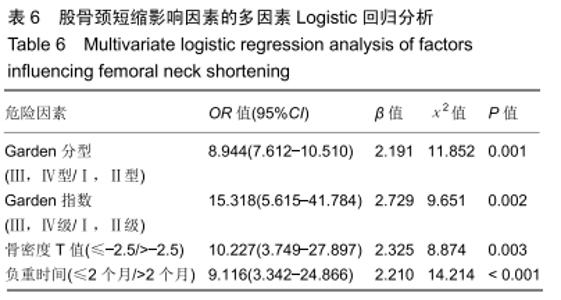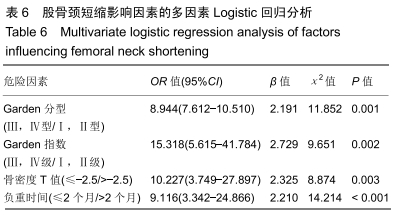Chinese Journal of Tissue Engineering Research ›› 2020, Vol. 24 ›› Issue (21): 3304-3309.doi: 10.3969/j.issn.2095-4344.2649
Previous Articles Next Articles
Incidence of femoral neck shortening after internal fixation of femoral neck fracture and prognostic factors
Mu Shuai1, 2, Xiao Peng3, Zhang Jianliang4, Hou Weiguang1, 5
- 1Southwest Medical University; 2Department of Orthopedics, Sichuan Bayi Rehabilitation Center; 3Department of Lower Limbs, Sichuan Provincial Orthopedic Hospital; 4Department of Lower Limbs, Pidu District Orthopedic Hospital of Chengdu City; 5Department of Orthopedics
-
Received:2019-10-15Revised:2019-10-17Accepted:2019-11-29Online:2020-07-28Published:2020-04-16 -
Contact:Hou Weiguang, Chief physician, Southwest Medical University, Luzhou 646000, Sichuan Province, China; Department of Orthopedics, AVIC 363 Hospital, Chengdu 610041, Sichuan Province, China -
About author:Mu Shuai, Master candidate, Attending physician, Southwest Medical University, Luzhou 646000, Sichuan Province, China; Department of Orthopedics, Sichuan Bayi Rehabilitation Center•Affiliated Rehabilitation Hospital of Chengdu University of TCM, Chengdu 611135, Sichuan Province, China -
Supported by:the Key Project of Health and Family Planning Commission of Sichuan Province, No. 16ZD042
CLC Number:
Cite this article
Mu Shuai, Xiao Peng, Zhang Jianliang, Hou Weiguang. Incidence of femoral neck shortening after internal fixation of femoral neck fracture and prognostic factors[J]. Chinese Journal of Tissue Engineering Research, 2020, 24(21): 3304-3309.
share this article
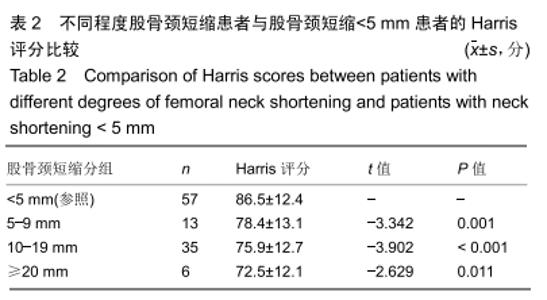
2.3 一般资料 111例患者中男46例(41.4%),女65例(58.6%),男女性别比0.71∶1;年龄18-87岁,平均 (57.6± 3.4)岁,其中≤60岁62例(55.9%),> 60岁49例(44.1%);左侧骨折58例,右侧53例;骨折Garden分型:Ⅰ型4例(3.6%),Ⅱ型22例(19.8%),Ⅲ型32例(28.8%),Ⅳ型52例(47.7%);术前Singh指数:Ⅰ-Ⅲ度71例(64.0%),Ⅳ-Ⅵ度40例(36.0%);复位质量Garden指数:Ⅰ、Ⅱ级解剖复位69例(62.2%),Ⅲ、Ⅳ级非解剖复位42例(37.8%);术后负重时间1-3个月,平均(1.8±0.3)个月;其中存在至少1种其他系统基础疾病者46例(41.4%),基础疾病主要包括原发性高血压(40例),2型糖尿病(21例),冠状动脉粥样硬化(20例),慢性支气管炎(12例)和房颤(11例)。受伤后至手术时间1-13 d,平均(3.4±0.9) d,其中≤4 d为63例(56.8%)、> 4 d为48例(43.2%)。受伤原因:交通伤45例(40.5%),高处坠落伤 36例(32.4%),摔伤/跌伤30例(27.0%)。 2.4 髋关节功能Harris评分及股骨颈短缩发生率 股骨颈不同短缩程度患者的髋关节功能Harris评分比较显示,股骨颈短缩5-9 mm、10-19 mm和≥20 mm三组的Harris评分均小于<5 mm组,差异有显著性意义(P均< 0.05),见表2。故可以按股骨颈短缩≥5 mm作为分界点,即股骨颈短缩发生率为48.6%(54/111),其中股骨颈短缩10-19 mm的发生率为31.5%(35/111),股骨颈短缩≥20 mm的发生率为5.4%(6/111)。 "
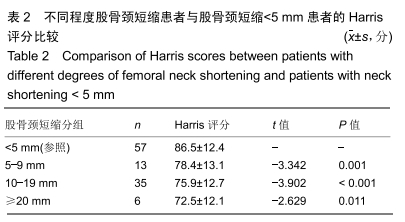
| [1] WANG XD, LAN H, LI KN. Treatment of femoral neck fractures with cannulated screw invasive internal fixation assisted by orthopaedic surgery robot positioning system. Orthop Surg. 2019; 11(5): 864-872. [2] PRITCHETT J. Large diameter total hip replacement for acute displaced femoral neck fracture. J Long Term Eff Med Implants. 2019;29(1):71-78. [3] MURPHY DK, RANDELL T, BRENNAN KL, et al. Treatment and displacement affect the reoperation rate for femoral neck fracture. Clin Orthop Relat Res. 2013;471(8): 2691-2702. [4] 曹发奇,周武,刘国辉,等.股骨颈骨折复位内固定术后股骨头坏死的相关因素分析[J].中华骨科杂志,2017,37(17):1088-1092. [5] 董忠,章镇南,吴斌.福州地区老年骨折患者回顾性分析[J].中国骨质疏松杂志,2018,24(7):949-953. [6] 孙宣,鲍自立,傅强,等.苏中地区3所中医院老年股骨颈与股骨粗隆间骨折的流行病学分析[J].中国骨与关节损伤杂志,2018,33(2): 161-162. [7] SAXER F, STUDER P, JAKOB M, et al. Minimally invasive anterior muscle-sparing versus a transgluteal approach for hemiarthroplasty in femoral neck fractures-a prospective randomised controlled trial including 190 elderly patients. BMC Geriatr. 2018; 18(1): 222. [8] VAN DER SIJP MPL, SCHIPPER IB, KEIZER SB, et al. Prospective comparison of the anterior and lateral approach in hemiarthroplasty for hip fractures: a study protocol . BMC Musculoskelet Disord. 2017; 18(1): 361. [9] FELTON J, SLOBOGEAN GP, JACKSON SS, et al. Femoral neck shortening after hip fracture fixation is associated with inferior hip function: Results From the FAITH Trial. J Orthop Trauma. 2019; 33(10):487-496. [10] WANG CT, CHEN JW, WU K, et al. Suboptimal outcomes after closed reduction and internal fixation of displaced femoral neck fractures in middle-aged patients: is internal fixation adequate in this age group? BMC Musculoskelet Disord. 2018; 19(1): 190. [11] HAIDER T, SCHNABEL J, HOCHPÖCHLER J, et al. Femoral shortening does not impair functional outcome after internal fixation of femoral neck fractures in non-geriatric patients . Arch Orthop Trauma Surg. 2018;138(11): 1511-1517. [12] DONG Q, HAN Z, ZHANG YG, et al. Comparison of transverse cancellous lag screw and ordinary cannulated screw fixations in treatment of vertical femoral neck fractures. Orthop Surg. 2019; 11(4): 595-603. [13] BORAIAH S, PAUL O, HAMMOUD S, et al. Predictable healing of femoral neck fractures treated with intraoperative compression and length-stable implants. J Trauma. 2010;69(1): 142-147. [14] 梁金龙,陆声.髋关节旋转中心测量方法的研究进展[J].中国矫形外科杂志,2014,22(6):512-515. [15] ZLOWODZKI M, JONSSON A, PAULKE R, et al. Shortening after femoral neck fracture fixation: is there a solution? Clin Orthop Relat Res. 2007; 461: 213-218. [16] BORAIAH S, PAUL O, HAMMOUD S, et al. Predictable healing of femoral neck fractures treated with intraoperative compression and length-stable implants. J Trauma. 2010;69(1): 142-147. [17] WANG G, TANG Y, WANG B, et al. Minimally invasive open reduction combined with proximal femoral hollow locking plate in the treatment of Pauwels type III femoral neck fracture . J Int Med Res. 2019; 47(7): 3050-3060. [18] CRONIN PK, FRECCERO DM, KAIN MS, et al. Garden 1 and 2 femoral neck fractures collapse more than expected after closed reduction and percutaneous pinning. J Orthop Trauma. 2019; 33(3): 116-119. [19] ROGMARK C, KRISTENSEN MT, VIBERG B, et al. Hip fractures in the non-elderly-Who, why and whither? Injury. 2018; 49(8): 1445-1450. [20] BARTELS S, GJERTSEN JE, FRIHAGEN F, et al. Low bone density and high morbidity in patients between 55 and 70 years with displaced femoral neck fractures: a case-control study of 50 patients vs 150 normal controls. BMC Musculoskelet Disord. 2019; 20(1):371. [21] WANG WT, LI YQ, GUO YM, et al. Risk factors for the development of avascular necrosis after femoral neck fractures in children: a review of 239 cases. Bone Joint J. 2019;101(9):1160-1167. [22] VENKATADASS K, AVINASH M, RAJASEKARAN S. Bilateral avascular necrosis of the femoral head following asynchronous postictal femoral neck fractures: a case report and review of the literature . J Pediatr Orthop B. 2018;27(3):274-278. [23] 姜达君,贾伟涛,张长青.青壮年股骨颈骨折复位技巧和内固定选择[J]. 中华创伤骨科杂志,2018,20(7):588-593. [24] CHEN X, ZHANG J, WANG X, et al. Incidence of and factors influencing femoral neck shortening in elderly patients after fracture fixation with multiple cancellous screws. Med Sci Monit. 2017;26(23): 1456-1463. [25] BARQUET A, GIANNOUDIS PV, GELINK A, et al. Femoral neck fractures after removal of hardware in healed trochanteric fractures. Injury. 2017;48(12):2619-2624. [26] 夏希,刘智. 老年股骨颈骨折空心螺钉固定术后颈短缩的测量及其对髋关节功能的影响[J].中华创伤骨科杂志,2014,16(8):651-655. [27] 王志生,吴志新.多方向空心钉内固定对股骨颈骨折术后颈短缩的控制[J].中国矫形外科杂志,2016,24(14):1253-1257. [28] YE Y, CHEN K, TIAN K, et al. Medial buttress plate augmentation of cannulated screw fixation in vertically unstable femoral neck fractures: Surgical technique and preliminary results. Injury. 2017; 48(10): 2189-2193. [29] WEIL YA, QAWASMI F, LIEBERGALL M, et al. Use of fully threaded cannulated screws decreases femoral neck shortening after fixation of femoral neck fractures. Arch Orthop Trauma Surg. 2018;138(5): 661-667. [30] ZHANG B, LIU J, ZHU Y, et al. A new configuration of cannulated screw fixation in the treatment of vertical femoral neck fractures. Int Orthop.2018;42(8): 1949-1955. [31] 冯晓飞,余霄,庞清江.股骨颈骨折内固定术后股骨颈短缩的临床特点[J].中华骨与关节外科杂志,2018,11(5):364-369. [32] GUO J, DONG W, JIN L, et al. Treatment of basicervical femoral neck fractures with proximal femoral nail antirotation . J Int Med Res. 2019;47(9):4333-4343. [33] NANTY L, CANOVAS F, RODRIGUEZ T, et al. Femoral neck shortening after internal fixation of Garden I fractures increases the risk of femoral head collapse. Orthop Traumatol Surg Res. 2019;105(5): 999-1004. [34] GUO J, DONG W, YIN B, et al. Intramedullary nails with cannulated screw fixation for the treatment of unstable femoral neck fractures. J Int Med Res. 2019;47(2): 557-568. [35] NANTY L, CANOVAS F, RODRIGUEZ T, et al. Femoral neck shortening after internal fixation of Garden I fractures increases the risk of femoral head collapse. Orthop Traumatol Surg Res. 2019;105(5): 999-1004. [36] OKIKE K, UDOGWU UN, ISAAC M, et al. Not all garden-i and ii femoral neck fractures in the elderly should be fixed: effect of posterior tilt on rates of subsequent arthroplasty. J Bone Joint Surg Am. 2019;101(20):1852-1859. [37] WEIL YA, KHOURY A, ZUAITER I, et al. Femoral neck shortening and yams collapse after navigated fixation of intracapsular femoral neck fractures. J Orthop Trauma. 2012;26(1):19-23. [38] MIN BW, LEE KJ, BAE KC, et al. Result of internal fixation for stable femoral neck fractures in elderly patients. Hip Pelvis. 2016; 28(1): 43-48. [39] SUNG YB, JUNG EY, KIM KI, et al. Risk factors for neck shortening in patients with valgus impacted femoral neck fractures treated with three parallel screws: is bone density an affecting factor? Hip Pelvis. 2017;29(4): 277-285. |
| [1] | Xu Feng, Kang Hui, Wei Tanjun, Xi Jintao. Biomechanical analysis of different fixation methods of pedicle screws for thoracolumbar fracture [J]. Chinese Journal of Tissue Engineering Research, 2021, 25(9): 1313-1317. |
| [2] | Zhang Tongtong, Wang Zhonghua, Wen Jie, Song Yuxin, Liu Lin. Application of three-dimensional printing model in surgical resection and reconstruction of cervical tumor [J]. Chinese Journal of Tissue Engineering Research, 2021, 25(9): 1335-1339. |
| [3] | Du Xiupeng, Yang Zhaohui. Effect of degree of initial deformity of impacted femoral neck fractures under 65 years of age on femoral neck shortening [J]. Chinese Journal of Tissue Engineering Research, 2021, 25(9): 1410-1416. |
| [4] | Zhang Shangpu, Ju Xiaodong, Song Hengyi, Dong Zhi, Wang Chen, Sun Guodong. Arthroscopic suture bridge technique with suture anchor in the treatment of acromioclavicular dislocation [J]. Chinese Journal of Tissue Engineering Research, 2021, 25(9): 1417-1422. |
| [5] | Zhou Jihui, Li Xinzhi, Zhou You, Huang Wei, Chen Wenyao. Multiple problems in the selection of implants for patellar fracture [J]. Chinese Journal of Tissue Engineering Research, 2021, 25(9): 1440-1445. |
| [6] | Chen Junming, Yue Chen, He Peilin, Zhang Juntao, Sun Moyuan, Liu Youwen. Hip arthroplasty versus proximal femoral nail antirotation for intertrochanteric fractures in older adults: a meta-analysis [J]. Chinese Journal of Tissue Engineering Research, 2021, 25(9): 1452-1457. |
| [7] | Hu Kai, Qiao Xiaohong, Zhang Yonghong, Wang Dong, Qin Sihe. Treatment of displaced intra-articular calcaneal fractures with cannulated screws and plates: a meta-analysis of 15 randomized controlled trials [J]. Chinese Journal of Tissue Engineering Research, 2021, 25(9): 1465-1470. |
| [8] | Xu Yulin, Shen Shi, Zhuo Naiqiang, Yang Huilin, Yang Chao, Li Yang, Zhao Heng, Zhao Lu. Biomechanical comparison of three different plate fixation methods for acetabular posterior column fractures in standing and sitting positions [J]. Chinese Journal of Tissue Engineering Research, 2021, 25(6): 826-830. |
| [9] | Hou Guangyuan, Zhang Jixue, Zhang Zhijun, Meng Xianghui, Duan Wen, Gao Weilu. Bone cement pedicle screw fixation and fusion in the treatment of degenerative spinal disease with osteoporosis: one-year follow-up [J]. Chinese Journal of Tissue Engineering Research, 2021, 25(6): 878-883. |
| [10] | He Li, Tian Wei, Xu Song, Zhao Xiaoyu, Miao Jun, Jia Jian. Factors influencing the efficacy of lumbopelvic internal fixation in the treatment of traumatic spinopelvic dissociation [J]. Chinese Journal of Tissue Engineering Research, 2021, 25(6): 884-889. |
| [11] | Yang Weiqiang, Ding Tong, Yang Weike, Jiang Zhengang. Combined variable stress plate internal fixation affects changes of bone histiocyte function and bone mineral density at the fractured end of goat femur [J]. Chinese Journal of Tissue Engineering Research, 2021, 25(6): 890-894. |
| [12] | Zhang Lei, Ma Li, Fu Shijie, Zhou Xin, Yu Lin, Guo Xiaoguang. Arthroscopic treatment of greater tuberosity avulsion fractures with anterior shoulder dislocation using the double-row suture anchor technique [J]. Chinese Journal of Tissue Engineering Research, 2021, 25(6): 895-900. |
| [13] | Yuan Xinping, Shao Yanbo, Wu Chao, Wang Jianling, Tong Liangcheng, Li Ying. Accuracy of target bone segments in personalized differential modeling and simulation of CT scanning parameters at fracture end [J]. Chinese Journal of Tissue Engineering Research, 2021, 25(6): 912-916. |
| [14] | Song Chengjie, Chang Hengrui, Shi Mingxin, Meng Xianzhong. Research progress in biomechanical stability of lateral lumbar interbody fusion [J]. Chinese Journal of Tissue Engineering Research, 2021, 25(6): 923-928. |
| [15] | Kong Lingbao, Lü Xin. Effect of implant selection and approach on support in the operation of posterolateral tibial plateau fractures [J]. Chinese Journal of Tissue Engineering Research, 2021, 25(6): 942-947. |
| Viewed | ||||||
|
Full text |
|
|||||
|
Abstract |
|
|||||


